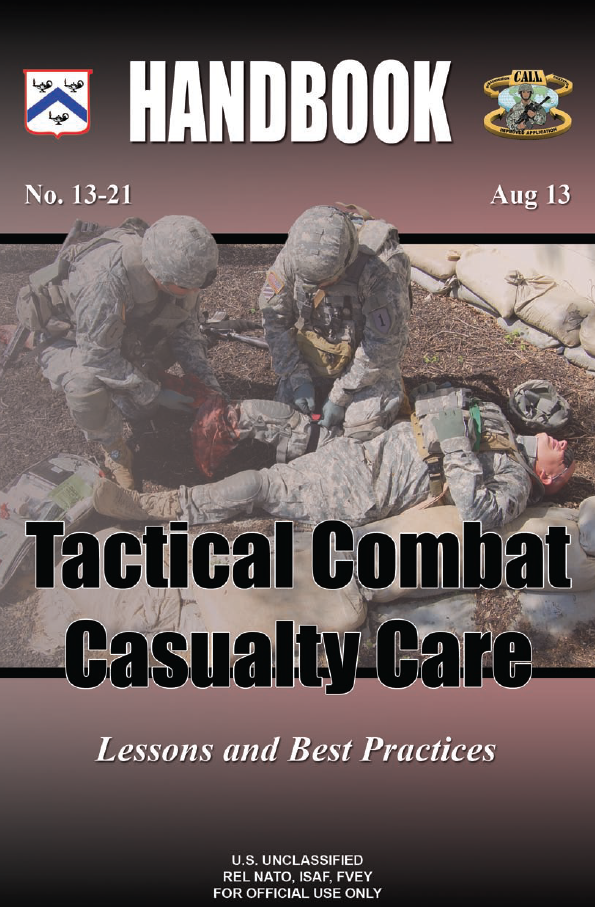The following document is an updated version of a handbook published by the Center for Army Lessons Learned in May 2010.
Center for Army Lessons Learned
- 101 pages
- For Official Use Only
- REL NATO, GCTF, ISAF, MCFI, ABCA
- August 2013
Tactical Combat Casualty Care (TCCC) is the pre-hospital care rendered to a casualty in a tactical, combat environment. The principles of TCCC are fundamentally different from those of traditional civilian trauma care, which is practiced by most medical providers and medics. These differences are based on both the unique patterns and types of wounds that are suffered in combat and the tactical environment medical personnel face in combat. Unique combat wounds and tactical environments make it difficult to determine which intervention to perform at what time. Besides addressing a casualty’s medical condition, responding medical personnel must also address the tactical situation faced while providing casualty care in combat. A medically correct intervention performed at the wrong time may lead to further casualties. Stated another way, “good medicine may be bad tactics,” which can get the rescuer and casualty killed. To successfully navigate these issues, medical providers must have skills and training focused on combat trauma care, as opposed to civilian trauma care.
Casualties and Wounds
On the battlefield, the pre-hospital period is the most important time to care for any combat casualty. In previous wars, up to 90 percent of combat deaths occurred before a casualty reached a medical treatment facility. This highlights the primary importance of treating battlefield casualties at the point of injury, prior to tactical evacuation care and arrival at a treatment facility.
Specifi cally, combat deaths result from the following:
• 31 percent: Penetrating head trauma.
• 25 percent: Surgically uncorrectable torso trauma.
• 10 percent: Potentially correctable surgical trauma.
• 9 percent: Exsanguination.*
• 7 percent: Mutilating blast trauma.
• 3-4 percent: Tension pneumothorax (PTX).*
• 2 percent: Airway obstruction/injury.*
• 5 percent: Died of wounds (mainly infection and shock).
*Potentially Survivable(Note: Numbers do not add up to 100 percent. Not all causes of death are listed. Some deaths are due to multiple causes.)
A significant percentage of these deaths (highlighted above in bold type) are potentially survivable with proper, timely intervention. Of these avoidable deaths, the vast majority are due to exsanguination and airway or breathing difficulties, conditions that can and should be addressed at the point of injury. It has been estimated that of all potentially survivable deaths, up to 90 percent of them can be avoided with the simple application of a tourniquet for extremity hemorrhage, the rapid treatment of a PTX, and the establishment of a stable airway.3
On the battlefield, casualties will fall into three general categories:
• Casualties who will live, regardless of receiving any medical aid.
• Casualties who will die, regardless of receiving any medical aid.
• Casualties who will die if they do not receive timely and appropriate medical aid.TCCC addresses the third category of casualties — those who require the most attention of the medical provider during combat.
…
TCCC Goals
TCCC presents a system to manage combat casualties that takes the issues discussed above into consideration. The guiding principle of TCCC is performing the correct intervention at the correct time in the continuum of field care. TCCC is ultimately structured to meet three important goals:
• Treat the casualty.
• Prevent additional casualties.
• Complete the mission.Stages of Care
In thinking about the management of combat casualties, it is helpful to divide care into three distinct phases, each with its own characteristics and limitations:
• Care under fire is the care rendered at the point of injury while both the medic and the casualty are under effective hostile fire. The risk of additional injuries from hostile fire at any moment is extremely high for both the casualty and the medic. Available medical equipment is limited to that carried by the medic and the casualty.
• Tactical field care is the care rendered by the medic once he and the casualty are no longer under effective hostile fire. It also applies to situations in which an injury has occurred on a mission but there has been no hostile fire. Available medical equipment is still limited to that carried into the field by mission personnel. Time to evacuation may vary from minutes to hours.
• Tactical evacuation care is the care rendered once the casualty has been picked up by an aircraft, vehicle, or boat. Additional medical personnel and equipment that has been pre-staged in these assets should be available during this phase of casualty management. The chapters and sections of this handbook will present a discussion of each stage of TCCC as well as instructions for the procedures TCCC requires.

